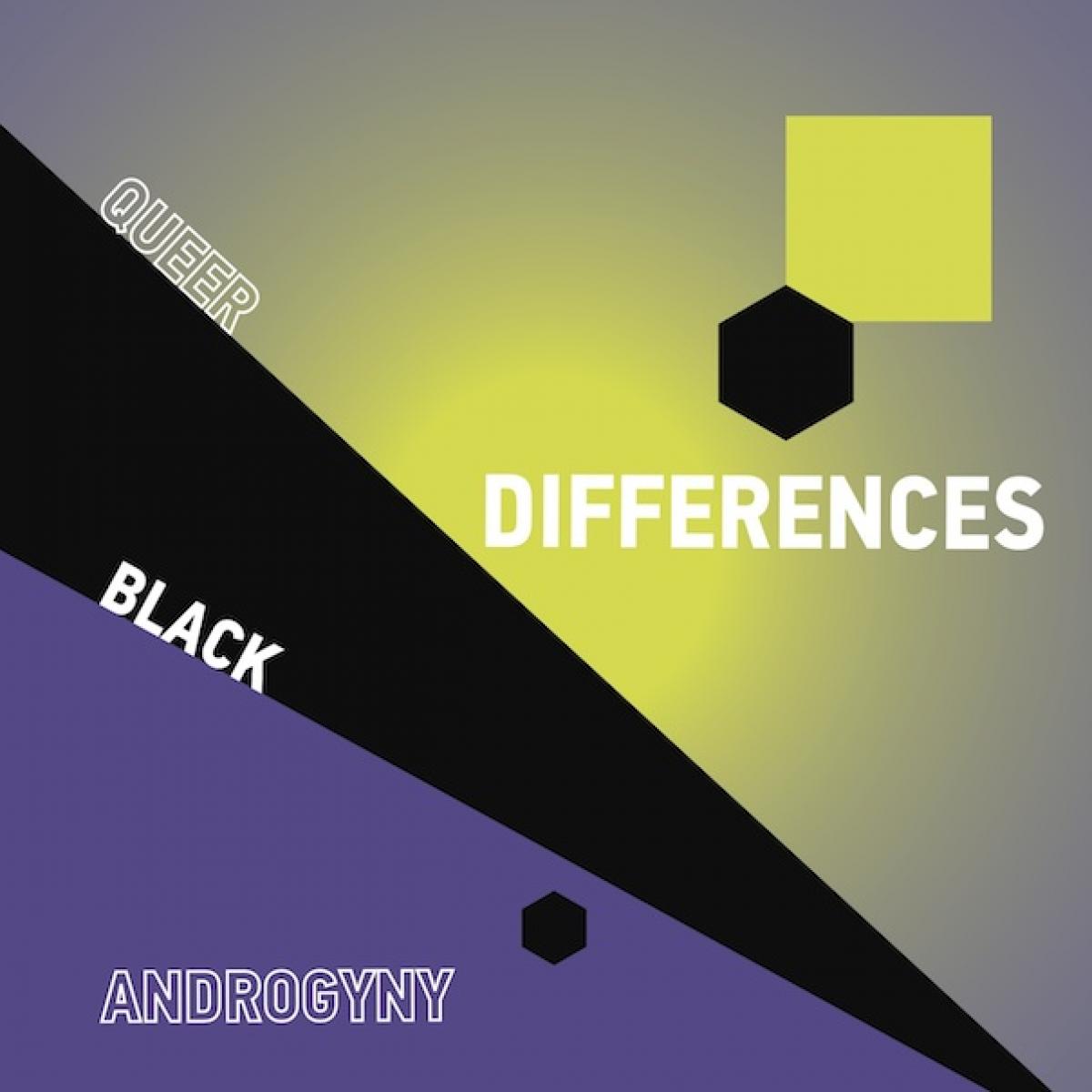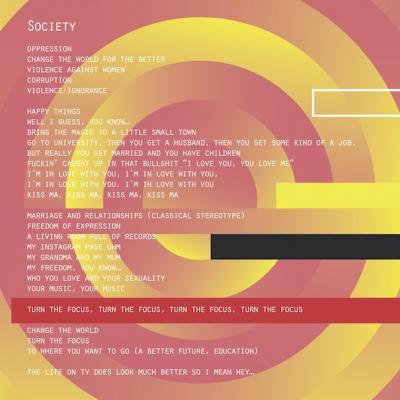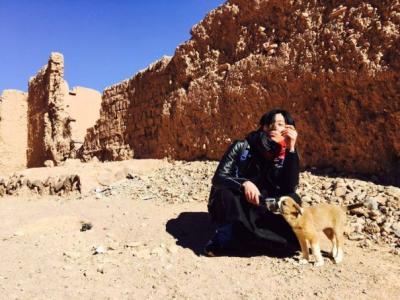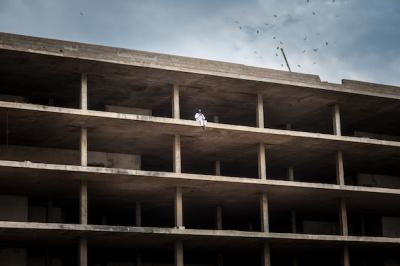
«Matter of Fact» by Svetlana Maraš
For her audio-visual cut-up composition Matter of Fact, Serbian composer Svetlana Maraš has sampled, remixed and developed the interview material used in the Norient exhibition Seismographic Sounds – Visions of a New World. Matter of Fact has premiered as an interactive installation at CTM Festival Berlin 2016. Now the work startes a new life as a DVD, co-produced by Norient. Order and download the DVD via our shop on Bandcamp or BigCartel.
[Poetryfilmkanal]: How did you develop the idea to Matter of Fact?
[Svetlana Maraš]: Matter of Fact was created after invitation from Norient to make an installation for their exhibition Seismographic Sounds at CTM festival 2016. I like working with existing materials and actually cut-up method became inherent to much of my work. I got plenty of materials from Norient and the idea was that I make a new piece using these materials in any way that I want.
[PFK]: The Beat Generation made great use of the of cut-up method. Can you tell us how you came across this working method?
[SM]: My first composition made with cut-up technique was «Poetica micromix». So far it is my most performed piece. The composition was produced for radio broadcast. At the time I was composing electro-acoustic music and started playing live electronic music, but at the same time I felt a great urge for the sound of the human voice. I was never a singer myself and I had the idea of a great diversity of colors and sounds produced by the human voice, that one singer alone couldn’t provide. Instead, I took around 20 recordings of vocal music that I knew, had and liked and chopped them to the smallest possible pieces – fragments sometimes shorter than a second. I got a very rich and diverse pallete of sounds that I used to put together for a new piece of music.
When I discovered vocal music genres that were far from the conventional use of the voice, I instantly felt connected. This is why I have a strong relationship to sound poetry for example even though I never had any wish to perform that kind of music myself. To summarize, I think that using the cut-ups of human voice comes from the need of this «ideal» singer who could provide me (the composer) with a wide range of vocal materials that I can use in a composition. This singer (voice) is obviously very fragmented and complex, fruitful and contrasting, both male and female.
[PFK]: In which way did you apply the cut-up method to your interactive installation you premiered at CTM in 2016?
[SM]: The recordings I took are mainly interviews with participating artists. They talked about several topics such as their position in society as musicians, their view of current situation in music industry and similar. I selected cut-ups based on both meaning and their musical value: good sound, nicely spoken words, interesting voices etc. By taking very small bits and pieces from their talks, mostly a word or two, these extracts became de-contextualized and ready to be used with a completely new meaning. I had cut-ups with very general meaning that I was able to use in any of my topics – for example someone saying: «happy things» or «beginning state of something» or «problem». On the other hand, I created new meanings by combining the words such as «classical» and «stereotype» for example that I used in the Society piece. «Classical» may have originated from «classical music» or something, can’t remember! «Stereotype» could have referred to stereotypes in pop music in general. The word «mother», which brings intense dramatisation in the «Myself» piece originates from an artist introducing herself and saying: «I’m a sound artist, mother, activist …».
[PFK]: Are you interested in semiotics?
[SM]: Obviously, semiotics is something that interests me, and this always reflects directly on my works which brings text and music into relation. By moving in this field, I am able to play with the position of myself within the work. Regarding Matter of Fact, the lyrics are not really opinions of artists who gave the interviews, but they aren’t mine either. Maybe at some points I agree to some of them. Actually there is a lot of humor in the work – at points I can reflect on some general topics concerning most of us, but I can also reflect on myself. When the lyrics go: «my instagram page – classical stereotype, your music, your music – classical stereotype». It’s about young people in general, but it is also about me. As I said, sometimes it’s like a horoscope: so general that you can relate to it but it can also be so wrong and completely miss the point.
[PFK]: The five videos are difficult to put into a genre. At points they almost appear like music videos. How would you relate these videos to music clips?
[SM]: My compositions are made so to approximate pop music in many aspects. However, they are made with totally different strategies than those of pop music. Although it might seem like that, there are no real repetitions, there is a lot of diversity in treatment of the material. Even the pieces that apply beats could not be used in a DJ set, as they are not really accurate and even. There is always some kind of glitch or irregularity. This was a very interesting playground for me. Adding the lyrics in animation to this approximation of pop immediately brings up the association with karaoke but if you look and listen more closely, you will notice much more complexity that makes a distinction between this work and what you can see and hear on TV. There is also this «brainwashing» effect that you might relate to commercial videos such as «Turn the focus« and «Change the world» but these are just borrowed strategies, used with a great dosage of irony.

[PFK]: «Matter of Fact» has a very distinct aesthetic. How did Deana Petrović develop the visual style and the animation?
[SM]: The starting point for the visuals was that they should evoke associations about the text as little as possible. I realized that we have to narrow down visual elements literally to basics in order to achieve that. The visuals had to be as neutral as possible in regard to the interpretation of text and music, so it became clear that we were aiming towards something more like motion graphics design. As a consequence, we were basically left with colors, shapes and movement. The first two were provided by a graphic designer who did an excellent job in creating the distinctive «mood« of each video and she also created a kind of storyboard, envisioning what happens to these elements throughout the piece. Deana used her skills in animation to bring these to life, and the interpretation of the storyboards was not exact and contained a lot of improvisation. The text itself was dictating much as it needed to appear in precise moments in order to be readable, so this was the main thing. There are many ways of the text appearing and at times you might notice the direct influence of karaoke. All graphics can be devided into backgrounds, main elements, text and glitches. Of course the last ones correspond to those in music although they don’t appear necessarily at the same time as music glitches but they should indicate this «imperfection» in both domains. To animate these videos was a huge work, days and hours. At times, Deana had more than 500 layers of text and graphics for certain videos. If in the future we would work (without a tight deadline) on improving the animations, we could certainly achieve even more versitallity and smoothness.
[PFK]: In howfar does your sound art become something different through adding a visual layer of moving imagery?
[SM]: In essence, my works are always purely musical works. Main content is the sonic one – the quality of the material, its transformations, form, durations … However, it comes very natural for me to bring more layers into my works, and not only of a musical kind. These are just extensions that the nature of the work implies – not artificially added elements. I don’t think there is an objective way of listening – through stereo loudspeakers or headphones? In high-quality? Whilst sitting or whilst moving or walking? Why this particular size of speakers …? I guess I am always searching for the most adequate way to represent my music and this sometimes requires means being borrowed from other domains.
[PFK]: Would you define your sound collages as poetry? And the five films as poetry films?
[SM]: I do think that my work is in a way related to the field of sound poetry, and I think it is an interesting fusion of digital music and sound poetry – a meeting of two opposing things such as electronic sound and digital means of sound manipulation and the human voice. I often think about this dichotomy and it inspires much of my work. There were many musical reasons to compose the texts in such way so I would rather say it is sound poetry, than poetry alone. Rhythm, contrasts, gesture, structure, form – these are the essence of both music and the visuals. Animations are not interpreting the music but working on the same principles, all being inherent to text too.
Voice snippets used in Matter of Fact come from the following contributors of Seismographic Sounds:
Ali Gul Pir, Bishi, Bojan Djordjevic, C-drík Fermont, Chameleone, David Oppenheim, Effy B, Garo Gdanian, Graeme Miller, Heta Bilaletdin, Kamilya Jubran, Keko, Leila McCalla, Mazen Kerbaj, Meira Asher, Minuit De Lacroix, O-Marz, Christoph Oggierman, Patrick Kessler, Salome MC, Silvana Imam, singing in People (but I reversed it), Temi Dollface, Umlilo, Wayne Marshall, Yemi Alade.
This interview has been first published on Poetryfilmkanal and in: «Poetryfilm Magazin» 2016/2: «Ton und Voice-over im Poetryfilm?» (Weimar: LGT, p 80-81).
Biography
Biography
Shop

Published on February 03, 2017
Last updated on July 14, 2020
Topics
Loneliness can feel like isolation, but can also be a positive solitude by keeping distance from the worlds’ chaos.
Sampling is political: about the use of chicken clucks or bomb sounds in current music.
Does a crematorium really have worst sounds in the world? Is there a sound free of any symbolic meaning?



